I keep receiving random letters powershell script error.
I made a changing mouse scheme script based on system os theme. I keep receiving random letters as shown in the image below when running the powershell script:

This is my script:
param (
[Parameter(Mandatory=$true)][int]$daySegment2, # 0 = Day, 1 = Night
[Parameter(Mandatory=$true)][int]$daySegment4, # -1 = N/A, 0 = Sunrise, 1 = Day, 2 = Sunset, 3 = Night
[Parameter(Mandatory=$true)][bool]$nightMode, # True if night mode is enabled
[Parameter(Mandatory=$false)][string]$imagePath # Path to current wallpaper image
)
$Location = "~\AppData\Local\WinDynamicDesktop\scripts\globalScripts\NightValue.xml"
$PreviousNightValue = Import-CliXml $Location
$Location2 = "~\AppData\Local\WinDynamicDesktop\scripts\globalScripts\StartValue.xml"
$StartValue = Import-CliXml $Location2
$NightValue = If ($nightMode) {1} Else {$daySegment2}
if ( ($NightValue -eq 0 -and $StartValue -eq 1) -or ($NightValue -ne $PreviousNightValue -and $StartValue -eq 0 -and $NightValue -eq 0))
{
$RegConnect = [Microsoft.Win32.RegistryKey]::OpenRemoteBaseKey([Microsoft.Win32.RegistryHive]”CurrentUser”,”$env:COMPUTERNAME”)
$RegCursors = $RegConnect.OpenSubKey(“Control Panel\Cursors”,$true)
$RegCursors.SetValue(“”,”W11 Cursor Light HD v2.2 by Jepri Creations”)
$RegCursors.SetValue(“AppStarting”,”%SYSTEMROOT%\Cursors\W11_light_v2.2\working.ani”)
$RegCursors.SetValue(“Arrow”,”%SYSTEMROOT%\Cursors\W11_light_v2.2\pointer.cur”)
$RegCursors.SetValue(“Crosshair”,”%SYSTEMROOT%\Cursors\W11_light_v2.2\precision.cur”)
$RegCursors.SetValue(“Hand”,”%SYSTEMROOT%\Cursors\W11_light_v2.2\link.cur”)
$RegCursors.SetValue(“Help”,”%SYSTEMROOT%\Cursors\W11_light_v2.2\help.cur”)
$RegCursors.SetValue(“IBeam”,”%SYSTEMROOT%\Cursors\W11_light_v2.2\beam.cur”)
$RegCursors.SetValue(“No”,”%SYSTEMROOT%\Cursors\W11_light_v2.2\unavailable.cur”)
$RegCursors.SetValue(“NWPen”,”%SYSTEMROOT%\Cursors\W11_light_v2.2\handwriting.cur”)
$RegCursors.SetValue(“Person”,”%SYSTEMROOT%\Cursors\W11_light_v2.2\person.cur”)
$RegCursors.SetValue(“Pin”,”%SYSTEMROOT%\Cursors\W11_light_v2.2\pin.cur”)
$RegCursors.SetValue(“precisionhair”,”%SYSTEMROOT%\Cursors\W11_dark_v2.2\precision.cur”)
$RegCursors.SetValue(“SizeAll”,”%SYSTEMROOT%\Cursors\W11_light_v2.2\move.cur”)
$RegCursors.SetValue(“SizeNESW”,”%SYSTEMROOT%\Cursors\W11_light_v2.2\dgn2.cur”)
$RegCursors.SetValue(“SizeNS”,”%SYSTEMROOT%\Cursors\W11_light_v2.2\vert.cur”)
$RegCursors.SetValue(“SizeNWSE”,”%SYSTEMROOT%\Cursors\W11_light_v2.2\dgn1.cur”)
$RegCursors.SetValue(“SizeWE”,”%SYSTEMROOT%\Cursors\W11_light_v2.2\horz.cur”)
$RegCursors.SetValue(“UpArrow”,”%SYSTEMROOT%\Cursors\W11_light_v2.2\alternate.cur”)
$RegCursors.SetValue(“Wait”,”%SYSTEMROOT%\Cursors\W11_light_v2.2\busy.ani”)
$RegCursors.Close()
$RegConnect.Close()
$CSharpSig = @’
[DllImport("user32.dll", EntryPoint = "SystemParametersInfo")]
public static extern bool SystemParametersInfo(
uint uiAction,
uint uiParam,
uint pvParam,
uint fWinIni);
‘@
$CursorRefresh = Add-Type -MemberDefinition $CSharpSig -Name WinAPICall -Namespace SystemParamInfo –PassThru
$CursorRefresh::SystemParametersInfo(0x0057,0,$null,0)
}
ElseIf (($NightValue -eq 1 -and $StartValue -eq 1) -or ($NightValue -ne $PreviousNightValue -and $StartValue -eq 0 -and $NightValue -eq 1))
{
$RegConnect = [Microsoft.Win32.RegistryKey]::OpenRemoteBaseKey([Microsoft.Win32.RegistryHive]”CurrentUser”,”$env:COMPUTERNAME”)
$RegCursors = $RegConnect.OpenSubKey(“Control Panel\Cursors”,$true)
$RegCursors.SetValue(“”,”W11 Cursors Dark HD v2.2 by Jepri Creations”)
$RegCursors.SetValue(“AppStarting”,”%SYSTEMROOT%\Cursors\W11_dark_v2.2\working.ani”)
$RegCursors.SetValue(“Arrow”,”%SYSTEMROOT%\Cursors\W11_dark_v2.2\pointer.cur”)
$RegCursors.SetValue(“Crosshair”,”%SYSTEMROOT%\Cursors\W11_dark_v2.2\precision.cur”)
$RegCursors.SetValue(“Hand”,”%SYSTEMROOT%\Cursors\W11_dark_v2.2\link.cur”)
$RegCursors.SetValue(“Help”,”%SYSTEMROOT%\Cursors\W11_dark_v2.2\help.cur”)
$RegCursors.SetValue(“IBeam”,”%SYSTEMROOT%\Cursors\W11_dark_v2.2\beam.cur”)
$RegCursors.SetValue(“No”,”%SYSTEMROOT%\Cursors\W11_dark_v2.2\unavailable.cur”)
$RegCursors.SetValue(“NWPen”,”%SYSTEMROOT%\Cursors\W11_dark_v2.2\handwriting.cur”)
$RegCursors.SetValue(“Person”,”%SYSTEMROOT%\Cursors\W11_dark_v2.2\person.cur”)
$RegCursors.SetValue(“Pin”,”%SYSTEMROOT%\Cursors\W11_dark_v2.2\pin.cur”)
$RegCursors.SetValue(“precisionhair”,”%SYSTEMROOT%\Cursors\W11_dark_v2.2\precision.cur”)
$RegCursors.SetValue(“SizeAll”,”%SYSTEMROOT%\Cursors\W11_dark_v2.2\move.cur”)
$RegCursors.SetValue(“SizeNESW”,”%SYSTEMROOT%\Cursors\W11_dark_v2.2\dgn2.cur”)
$RegCursors.SetValue(“SizeNS”,”%SYSTEMROOT%\Cursors\W11_dark_v2.2\vert.cur”)
$RegCursors.SetValue(“SizeNWSE”,”%SYSTEMROOT%\Cursors\W11_dark_v2.2\dgn1.cur”)
$RegCursors.SetValue(“SizeWE”,”%SYSTEMROOT%\Cursors\W11_dark_v2.2\horz.cur”)
$RegCursors.SetValue(“UpArrow”,”%SYSTEMROOT%\Cursors\W11_dark_v2.2\alternate.cur”)
$RegCursors.SetValue(“Wait”,”%SYSTEMROOT%\Cursors\W11_dark_v2.2\busy.ani”)
$RegCursors.Close()
$RegConnect.Close()
$CSharpSig = @’
[DllImport("user32.dll", EntryPoint = "SystemParametersInfo")]
public static extern bool SystemParametersInfo(
uint uiAction,
uint uiParam,
uint pvParam,
uint fWinIni);
‘@
$CursorRefresh = Add-Type -MemberDefinition $CSharpSig -Name WinAPICall -Namespace SystemParamInfo –PassThru
$CursorRefresh::SystemParametersInfo(0x0057,0,$null,0)
}
$StartValue = 0
if (($NightValue -ne $PreviousNightValue))
{
$NightValue | Export-Clixml -path $Location
}
if ($StartValue -ne 0)
{
$StartValue | Export-Clixml -path $Location2
}
I tried removing some parts of the script, I think the problem stems for registry editing. But had no luck. the error kept showing no matter what I delete.
I tried putting the $PSStyle.OutputRendering='PlainText' at the top of my script, I received the same error. I tried setting the NO_COLOR to 1 inside my script. Did not fix the issue. I don't have access to the application that runs the script, I just can edit my script. BTW, that's started happening when the software started using PowerShell 7 instead of windows PowerShell(V5) I started getting this error.

